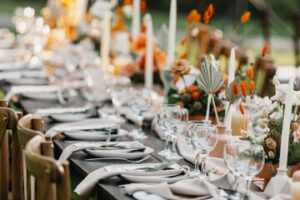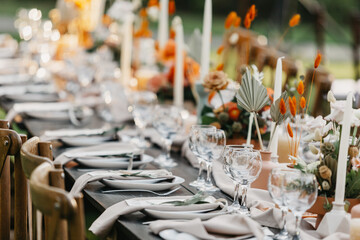When it comes to event designing, it’s important to understand your audience and the desired experience. Event Design Dallas will help you determine the theme and atmosphere of the event and ensure it aligns with your goals.
Lines are an important part of the event design process, balancing proportion and creating focal points. Consider using directional lighting to draw attention or lines on furniture and equipment to add character.

Lighting is a critical part of event design, as it conveys emotion and enhances the overall feel and theme of the event. For example, a blue lighting scheme might infuse intimacy, while a red lighting theme could fuel excitement and energy. Lighting is also a great way to highlight certain areas or decor elements. This can be done by using up lighters or projecting images onto the floor (gobo lighting).
Another key aspect of event design is defining the goals for the event and planning out how to achieve those goals. This may involve setting a theme or creating a unique atmosphere, as well as establishing the right type of audience for the event. In addition to this, the event planner should consider other details such as the venue, seating arrangements, and any special effects or entertainment.
Lastly, the event designer should experiment with different lighting techniques to create an immersive and memorable experience for attendees. This can include projection mapping, which transforms walls and stages into mesmerizing visual displays that transport guests to worlds beyond their imaginations. This can be complemented by LED tube lights, which can create a shimmering effect and create an ethereal feeling for attendees.
Scenography and furniture lighting can also add a unique touch to an event, especially when they reflect the colors of the corporate brand. This can be achieved by using back-lit furniture, transparencies, screens, and LED integration.
Colors are a powerful tool to create a mood for your event. Whether you use uplighting to add ambiance or a gobo to project your branding logo on the ceiling, colors help set your event’s theme and inspire emotional reactions in attendees.
A variety of emotions can be evoked with visual aesthetics, including serenity and energy. For example, a room with blue drapes may create a feeling of tranquility and calm, while a room with red and white curtains may evoke excitement and energy.
Color can have a positive or negative impact on people’s moods, and understanding how these feelings translate to different cultures is important for event design. For instance, black can symbolize power and wealth in some cultures, but it also represents death and infidelity in others.
Color can also have a psychological effect on the perception of time. For example, orange can energize the senses and stimulate appetite, while blue can calm the mind and reduce anxiety. This is important to keep in mind when designing your event, especially if you are looking to drive impulse purchases or increase ticket sales. For instance, using a bright red CTA button can create a sense of urgency and increase conversions, while softer hues like pink or green can encourage relaxation. Color can also be used to create a sense of direction for attendees in large event spaces. For example, using color to demarcate floor levels or create implied paths can help guide guests to registration lines and other key event elements.
Texture is both seen and felt, and it’s a key aspect of event design. The right textures can draw people in and captivate their imaginations. A bouncy rubber floor, for example, will make attendees want to jump on it. A fuzzy wall will encourage attendees to stroke it. And a rough, sand-textured wall can add an unexpected edge to a space.
Colors also play a major role in event design. The colors you and your convention planner choose will set the tone of your event, so make sure they complement your desired vibe. For instance, if you want to create a feeling of calm, you could use cool shades like greens and blues. Or, if you’re going for a more creative feel, vibrant hues like pink and orange will add a pop of fun.
Lastly, don’t forget about the importance of size. The scale of your event’s decor is important, especially when it comes to establishing focal points. A giant blown-up flower or sculpture can highlight an aspect of your design and create visual interest in the venue. On the other hand, too much size can overwhelm a room and take away from your design. The best way to test out the impact of size on your event’s design is by creating a mockup or prototype. This will help you visualize how the design materials will fit together in a physical setting and identify any issues before the event is held.
Creating a unique event space requires careful planning and attention to detail. Using creative lighting and decor, as well as ensuring that the venue is comfortable for your attendees, can help you create an event space that stands out from the rest. You can also incorporate a theme to make your event more memorable for your guests. Theme-based decor is a great way to create a unique space that is both visually appealing and aligned with your brand’s values and objectives.
It is important to understand that functionality plays a role in your event design as well. The layout of the event should allow for good flow and movement of delegates, as well as access to any event services that you may have booked. It is also important to consider the acoustics of the space, and how it will impact your delegates’ experience.
It is also a good idea to use a floor plan to map out the layout of your event space, so you can see how everything will fit together and if there is enough room for the elements you have planned. This is especially important if you are working with a limited budget, as it will help you avoid spending more than necessary on things that won’t have a big impact on your audience’s experience. It’s also a good idea to consult with a professional to ensure that you are getting the most value for your money.
A strong atmosphere is essential for creating an engaging event. The atmosphere can be created by incorporating several elements, such as lighting, color, and texture. Atmosphere is also determined by the way attendees interact with the space and each other. For example, if the event is a networking event, then it should include social activities to encourage interaction and connection. Atmosphere can also be affected by the music played at the event. For example, a corporate event may benefit from modern hip-hop music to create an energetic environment.
The venue size is also a critical factor in atmosphere. If there are too many people in a small area, it can feel cramped and uncomfortable. Conversely, if the venue is too large, it can feel empty and uninviting. Striking the right balance is challenging, but a well-designed event will ensure that the space feels comfortable and welcoming.
Visual displays are another important element of atmosphere, as they can convey information, reinforce branding, and captivate attendees. To enhance the atmosphere, choose decorations and signage that complement your theme and are on-brand. You can even use projection mapping and other immersive technologies to create an exciting and interactive experience for your guests. Also, consider integrating personalized touches that make attendees feel special and connected to the event. This could be as simple as a custom-designed welcome sign or branded giveaways.
Attendees are a critical part of any event, as they have the power to influence the overall experience. They can be a catalyst for learning and inspiration, so it is important to create an environment that encourages them to participate. The use of different colors, lighting, and decor can help to create a relaxing and engaging atmosphere for attendees. Incorporating a variety of seating options and group sizes can also foster discussion and collaboration.
Another way to enhance the attendee experience is by offering interactive sessions that will allow them to engage in a more meaningful way. These types of sessions can include workshops, simulations, or even icebreakers that are designed to be fun and engaging. Using unique venues like warehouses, tree houses, or sports stadiums can also add to the attendee experience.
Scent is also an effective design element to consider, as it can trigger specific memories and emotions. It is important to use scents that are related to the theme of your event and match the desired atmosphere. For example, the use of floral scents can evoke feelings of tranquility and relaxation.
A new generation of attendees has high expectations when it comes to event experiences, and relying on traditional approaches may not be enough. Event designers should be prepared to master a more interdisciplinary approach and utilize a wider range of skills to create the next generation of events.

